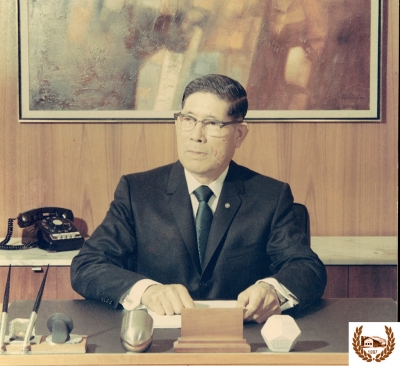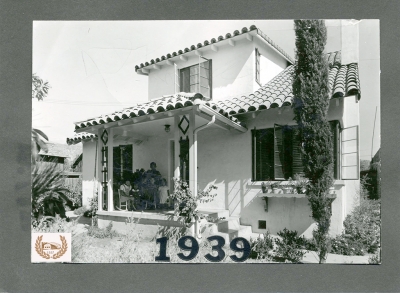|
By Gazette Staff Writers — Wednesday, October 20th, 2021
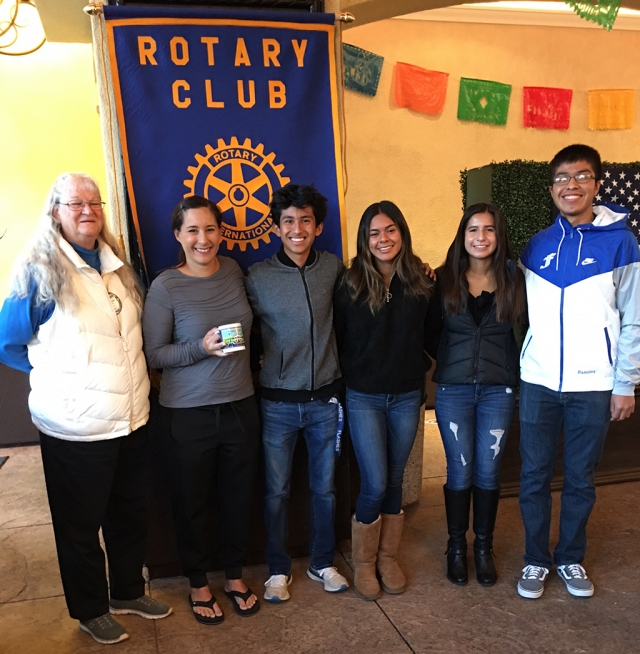 (l-r) Rotarian Cindy Blatt, Athletic Director Kim Tafoya, and four officers from the Fillmore High School Cross Country Team: Michael Camilo Torres, Alianna Tapia, Angelica Herrera and Diego Ramirez, who attended the Rotary meeting last week. Kim stated that these athletes are hard working, train for six months, running with distance between them at practice and must wear masks even when running. They are all committed to do their best in sports and academics. Photo courtesy Rotarian Martha Richardson. Enlarge Photo |
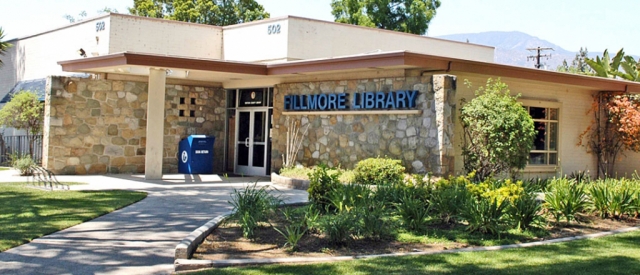 The construction on the Fillmore Library Expansion project is set to begin November 2021. The library will be closed to the public starting October 24, 2021, for an indefinite period of time (most likely 8 months). Until then the County Mobile Library will stop in Fillmore every Tuesday at City Hall. Enlarge Photo By Gazette Staff Writers — Wednesday, October 20th, 2021
Ventura County Library is pleased to announce that construction on the Fillmore Library Expansion project begins in early November 2021. This expansion project effectively doubles the footprint of the current Fillmore Library, meeting the needs of the growing community and providing new services to our Fillmore customers. The newly expanded library includes a classroom, two study rooms, an Innovation/STEAM lab/community meeting room, a designated computer lab with new public computers, new public laptops, useable outdoor areas, new public restrooms, and more. Due to the onsite construction, the Fillmore Library is closed to the public starting October 24, 2021 for an indefinite period of time (most likely about 8 months). To provide services to the Fillmore community during the temporary closure, the Ventura County Mobile Library is making weekly stops at Fillmore City Hall every Tuesday beginning Oct. 5, 2021. This schedule will continue until the expanded Fillmore Library reopens. At the Mobile Library stop customers may pick up holds, return items, get new library cards, participate in outdoor children’s programs such as a weekly Storytime (Tuesdays at 10:30am), browse new materials, and more. Additionally, during the closure, Fillmore customers may use the collections, services, and book drops at any other Ventura County Library (VCL) branch, of which there are 10 open locations throughout the county at this time. The closest VCL branches to Fillmore are: • Piru Library (3811 Center St., Piru 93040) and Our online eLibrary has ebooks, eaudiobooks, and more available for the community to use as well, all accessible 24/7 from your device. We understand this temporary closure of the Fillmore Library is inconvenient to community members, and we are sorry for that inconvenience. We are certain the newly expanded library will have tremendous positive impact in the community. Please visit vencolibrary.org/locations for information on alternative locations to use during the closure period, or vencolibrary.org/library-events for information on the weekly Mobile Library visit to Fillmore. For additional information, contact Nancy Schram, Ventura County Library Director at (805) 256-8535. |
 Inadomi Company store opened back in February 1925, pictured above is a Inadomi Delivery truck circa 1925 which was used to deliver groceries to customers. Photos courtesy Fillmore History Museum. Enlarge Photo By Gazette Staff Writers — Wednesday, October 20th, 2021
 The Inadomi store in 1925, where they sold groceries and other items to the community especially catering to the needs of Spanish speaking customers. Enlarge Photo  (l-r) (back row) Kumanosuke, Monda, & Wari (front row) Kaichiro with Yosh in his lap, Mitsuyo, & Midori. Enlarge Photo Courtesy Fillmore History Museum A house on Main Street, set back from the corner, represents so much more than the security of home and comfort. A well-known and well-loved local family, the Inadomi’s, built it in 1939 before World War II began. Soon it would bear witness to the tragedy of a dark moment in the history of the United States. Still standing over 80 years later it continues to remind us of this terrible event and gives us hope that it never happens again. Kaichiro Inadomi had emigrated from Japan in 1914 to join his father who was working for the Limoneira Ranch in Santa Paula. In 1922 he returned to Japan to marry Mitsuyu Ogawa. They returned to Ventura County where he continued with his job at Limoneira becoming a foreman at the age twenty two. In 1925, looking to improve the future for himself and his family, he decided to purchase a grocery store on Main St. in Fillmore. Because of the existing alien land laws in the U.S., Kaichiro, not being an American citizen, could not own property in this country. He was able to purchase the store with the help of an attorney, a Mr. Tanigoshi who bought the business in his Caucasian American wife’s name and then resold it to Kaichiro’ s American born children Yoshiharu and Taduko who were both under the age of 3 at the time. The Inadomi Company store opened on February 1, 1925. He sold groceries and other items to the community especially catering to the needs of Spanish speaking customers. Kaichiro soon became known as “John” or “Juan” to his Spanish speaking customers. He was active in the community and was a member of the Rotary Club and the Presbyterian Church. Initially the family lived in a “shack” behind the store but it was soon enlarged to shelter his growing family. In 1929 the store was enlarged and rebuilt of brick and in 1939 Kaichiro built a new house beside the store. Today the store is no longer there but the house still stands on the corner of Main St. and Clay St. Following the bombing of Pearl Harbor by the Japanese in 1941 the entire United States was gripped by fear and hysteria. The United States went to war with Germany, Italy, and Japan. On February, 19, 1942, President Roosevelt enacted Executive Order 9066 which allowed for the exclusion of suspect people from the coastal areas of the country. Families up and down both the east and west coasts of German, Italian, and Japanese descent were given a very short time to pack up and turn themselves in. The Inadomi family was included in this order. It is also to be noted that far fewer German and Italian individuals were interned than Japanese. At the time of the bombing of Pearl Harbor, Kaichiro owned three stores in Ventura County. They were located in Fillmore, Santa Paula, and Oxnard. His brother, Kumanosuke, owned a store in Ventura. The Inadomis were required to report to the authorities and be incarcerated in interment camps for the duration of the war. Many members of the community including: J. L. Strickland, President of Fillmore Rotary, Rev. William S. Orr, Pastor of the Presbyterian Church, and Fergus Fairbanks, Attorney, wrote letters on their behalf hoping to help the family stay in their Fillmore home. In spite of all of these efforts the family was still required to leave. In 1941 Kaichiro/ John wrote a letter to the Fillmore Herald expressing his appreciation for the people of Fillmore to “thank you for those kindnesses, and courtesies and evidences of good will.” When Order 9066 was implemented it gave the Japanese community mere days to deal with their homes, businesses, and possessions. Most sold or gave away everything they owned at a tremendous loss. They then reported to processing centers with the few possessions they could carry where they waited to be sent to interment camps. These camps were hastily built and located away from the coast, mostly in extreme hostile desert areas. At the rapidly built camps families were housed in cramped tarpaper barracks. Entire families lived together in just one or two rooms. There was no privacy and they had few household belongings. At most camps the people were treated like prisoners with guards and barbed wire fences. The Inadomis first reported to the Tulare Assembly Center and were later sent to the Gila River Camp on the Gila River Indian Reservation in Arizona, where John served as a meat buyer. In 1943 the family left for Colorado where they had purchased a farm in Yoshiharu’s name. John’s brother, Kumanosuke, “Manuel”, had already settled there. They remained in Colorado returning to Southern California in 1947 several years after the end of the war. While the family was away, the store was leased. Much of the Inadomi Company Store’s business had been run on a credit basis. When they left Fillmore over $65,000 was owed to them by people in the community. A few people sent their payments to the family in Arizona although there were still great losses. One local man and fellow Rotarian, Milo Cobb, continued to run the store and take care of the family’s possessions during the war. His granddaughter, Mary Gordon, recalls that her grandfather ran the business as if it were his own and returned it and the proceeds to the Inadomis upon the family’s return. The two families, the Cobbs and Inadomis remained close friends until their passing. In 1947, John sold the farm in Colorado. As the Fillmore store was still under lease, the family did not return to Fillmore. Instead they moved to East Los Angeles where they opened a chain of grocery stores because “Los Angeles had a bigger future” and because the rest of the extended family was there. Their “JonSons” chain of stores was very successful and Kaichiro once again became a valued member of the local community. He was president of the Southern California Grocers’ Association, a director of the Pan American Bank, president of the Japanese-American Community Service of Southern California, and president of the Belvedere Rotary Club with 27 years of perfect attendance. The laws regarding citizenship changed and Mr. and Mrs. Inadomi became US citizens on June 25, 1954. Their granddaughter, Patricia Inadomi, wrote “Great Expectations” about her grandparents’ life and experiences based on interviews with family members. Patricia says that her grandparents were not bitter over their losses. They loved the United States, their adopted home, because, “He felt it would provide a better life for his family.” In spite of the many losses due the war he was able to assure a better life and future for his children and future generations. With thanks to the following for their information. |
|
By Gazette Staff Writers — Wednesday, October 13th, 2021
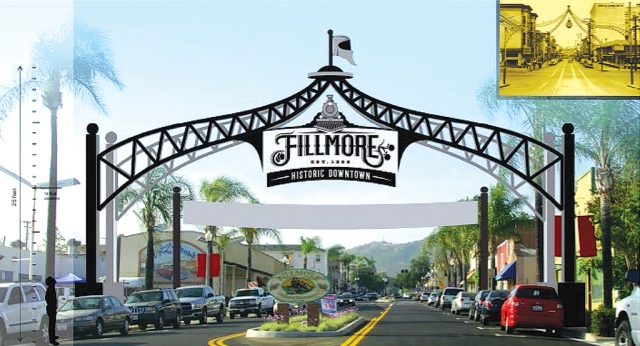 On October 12th, at Tuesday night’s City Council meeting, Fillmore Rotary Club proposed a Legacy Sign project to Council. The two Gateway designs installation is meant to honor the hardworking men and women of Fillmore’s past, present and future. Themed after elements of the town’s history, each design is forged with architectural steel to symbolize the town’s lasting impact. While the concepts you see before you are preliminary and can be altered accordingly, we believe the theme should reflect Fillmore’s rich history. Above is a rendering of the proposed arch for Central Avenue. Inset, the locomotive with arch proposed for east and west Highway 126. Photos courtesy City of Fillmore. Enlarge Photo |
|
By Gazette Staff Writers — Wednesday, October 13th, 2021
Vacancy on City Council. Should the City Council desire to make an appointment, staff recommends that the City Council: A proclamation and presentation by Mayor Mark Austin on Breast Cancer Awareness Month. Dr. John Fankhauser, CEO of VCMC and Santa Paula Hospital, spoke, with Lorena Hoover, Radiologic Specialist II. The Doctor spoke of the activity at Santa Paula Hospital, and their great new equipment. 5-B. ROTARY LEGACY SIGN PROJECT- RENEE SWENSON. 5-C KEVIN MCSWEENEY, PLANNING AND COMMUNITY DEVELOPMENT DIRECTOR, gave an update on City Housing Element. 7-A Council Adopted City Council Resolution 21-3843 approving the Destruction of Certain Obsolete Records and directing the City Clerk to carry out this process. 7-B City Council approved by Resolution the Memorandum of Understanding between City of Fillmore and International Union of Operating Engineers Local 501 Agreement for the period of July 1, 2021, through June 30, 2024. 8-B Staff recommend, and City Council approved and introduced, the first reading of Ordinance No. 21-934, creating a new Chapter 8.10 in the FMC entitled: “AN ORDINANCE OF THE CITY COUNCIL OF THE CITY OF FILLMORE, CALIFORNIA, ADDING CHAPTER 8.10 TO TITLE 8 (“HEALTH AND SANITATION”) OF THE FILLMORE MUNICIPAL CODE, ENTITLED “SPECIFIC REGULATIONS FOR ORGANICS WASTE DISPOSAL REDUCTION, RECYCLING AND SOLID WASTE COLLECTION,” TO ENACT REGULATIONS IN COMPLIANCE WITH SENATE BILL (SB) 1383 FOR THE IMPLEMENTATION OF FOOD AND ORGANICS RECYCLING AND RELATED SOLID WASTE AND RECYCLING PROCESSING AND REPORTING AND ADOPTION OF EXEMPTION FROM THE CALIFORNIA ENVIRONMENTAL QUALITY ACT” Chapter 12 of Title 14, Division 7 of the California Code of Regulations (“CCR”) requires the City adopt an ordinance of similarly enforceable mechanism by January 1, 2022. CalRecycle is mandating SB 1383 implementation through such an enforceable mechanism no later than the January 1 deadline. 8-D Waving of THE SINGLE EVENT BUSINESS LICENSE PERMIT FEE FOR VENDORS WHO ARE 8-F Emergency repairs to WELL #8 and request Council determine emergency remains pursuant to CA Public Contract Code Sec. 22050 and authorization of additional funding. Total $350,000. 8-G Public Hearing, Santa Clara Street and Central Ave. So CA Edison Rule 20A funds and finding exemption from CEQA. |
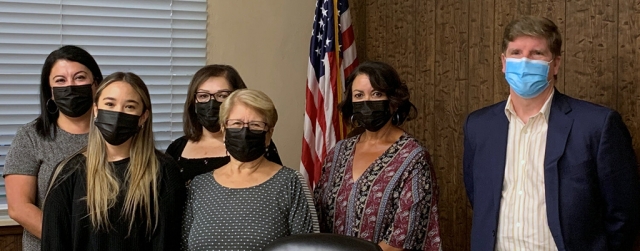 On October 5th Fillmore Unified School District appointed Fillmore High School senior Chloie Martinez as the 2021-22 Student Board Member Representative. Pictured (l-r) is Superintendent Christine Schieferle, Chloie Martinez, Board Member Olivia Palacio, Clerk Lucy Rangel, President Tricia Gradias, Vice President Sean Morris. Photo courtesy Fillmore Unified School Website. Enlarge Photo By Gazette Staff Writers — Wednesday, October 13th, 2021
Courtesy Christine Schieferle, Superintendent, Fillmore Unified School District On October 5th, the FUSD Governing Board appointed Fillmore High School Senior, Chloie Martinez as the 2021-22 Student Board Member Representative. Chloie Martinez is a senior at Fillmore High School, maintaining a 4.0+gpa, Associate Student Body Secretary, Varsity Cheer Captain, and actively taking college courses in the Ventura Community College District since 8th grade. Additionally, she holds multiple leadership positions at Fillmore High School, including Rotary, Cards for Kindness, Flashes Unified, and Sports Medicine club. Previously she has taken part in the HOBY Youth Leadership Seminar, Rotary Youth Leadership Awards, and student representative for the City of Fillmore’s Recreation and Parks Commission. Chloie looks forward to graduation and enrolling in a University in the Fall of 2022. We welcome Chloie to the FUSD Governance Team and look forward to her student reports and input. Go Flashes! |
|
By Gazette Staff Writers — Wednesday, October 13th, 2021
The City Council is searching for applicants to fill one vacancy. Interested applicants, please apply before October |
|
By Gazette Staff Writers — Wednesday, October 13th, 2021
 The Autumn Community Festival was held on Friday, October 8th from 5pm to 9pm, at Fillmore’s Central Park. The community gathered to enjoy a Halloween pet parade, pumpkin decorating, vendors, jumpers, live music and more. The festival kicked off the first of many City events to return. Enlarge Photo |
|
By Gazette Staff Writers — Wednesday, October 13th, 2021
 On Friday, October 8th, at the Fillmore Boy’s and Girls Club, a big shout-out to Fillmore’s Steve Conway for coming out and teaching the kids how to cook a steak. And thanks to Patrick Maynard for putting this awesome event together. Tasty goodness! Photos courtesy Boys & Girls Club of SCV. Enlarge Photo |
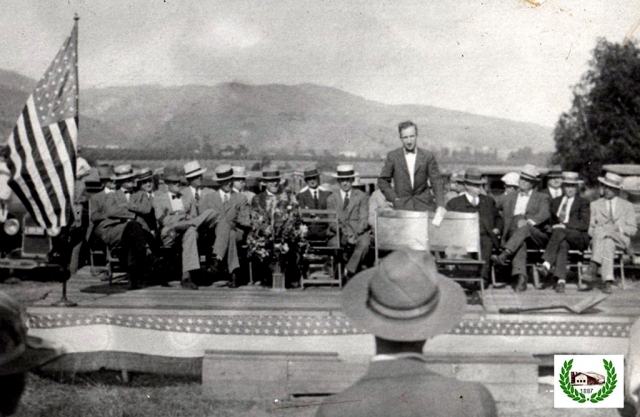 John Galvin speaking at Monorail Groundbreaking in 1927. Photos courtesy Fillmore Historical Museum. Enlarge Photo By Gazette Staff Writers — Wednesday, October 13th, 2021
Courtesy Fillmore Historical Museum We say Fillmore was founded in 1887 when the railroad came through, but it was not an actual town until 1914 when it was incorporated. Incorporation was not an assured event. There was strong opposition, mainly on the basis that creating a city would put another layer of taxes on the locals. On the other side was the argument that taxes currently being paid weren’t coming back to the local residents but being spent elsewhere in the county. Streets were not paved and the only paved sidewalks were those put in by the adjacent business owner. In August of 1914 the election was held with the vote split 208 for incorporation and 193 against. Fillmore became the newest city in Ventura County. In the same election George Tighe, the first station master and store owner, was elected mayor and Clarence Arrasmith was elected city clerk. Besides Tighe on the “board of trustees”, forerunner to the city council, were Bowman Merrill, druggist; E. O. Goodenough, merchant; E. A. Pyle, “financier”; and S. H. Mosher, hardware merchant. At the first trustee meeting two additional officials were appointed – John Galvin as city attorney and Jack Casner, city marshal, both would receive the salary of $25 per month. Two of the new city officials would serve Fillmore well into the second half of the twentieth century – Clarence Arrasmith and John Galvin. John Galvin was born in Kentucky in 1888, but grew up in Rawlins, Wyoming, where he graduated from high school. He then went to the University of Michigan Law School, graduating in 1910. Immediately on graduation he moved to California, originally settling in Oxnard but finding no legal work there got a job at the sugar beet factory. A chance meeting with C. C. Elkins brought him to Fillmore in 1911. In 1913, other family members from Rawlins moved to Fillmore. His father, Warren, was employed as a bookkeeper at the refinery. His brother, Warren, served in World War One, then worked as an electrician before serving in various law enforcement positions. His sister, Leona, worked in the post office for many years and was active in the Soroptimists. Sister Mary graduated from Fillmore High school in 1919 and worked for several years at United Mercantile before graduating from the USC School of Music and having a career teaching in El Rio and the Briggs School district before coming to Fillmore school in 1942. Mary was the beloved kindergarten teacher to several generations of the children of our community. Youngest sister, Katherine, graduated from Fillmore High school in 1923 and married William Grady who also worked for the Post Office. Mary and Katherine were both accomplished musicians and entertained at Clarence Arrasmith’s “Happy Hours.” When asked how he was chosen with little experience to be city attorney, he replied, “It happened I was in the right place at the right time to draw up the incorporation papers and become the attorney. I had personality, obvious and unimpeachable character and I was the only attorney in town.” (Fergus Fairbanks was working as clerk at the Fillmore State Bank but hadn’t finished law school yet). In July, 1920, he married Elizabeth Grenier, who was a teacher at Fillmore Union High School. City Attorney was not a full-time job. John Galvin had a busy practice handling both civil and criminal cases. In addition to his legal work, he was active in community and county activities. As a public speaker he was also in demand. The May 3rd, 1934, Piru News reported that “Aside from the fact that Johnny Galvin is one of the most capable lawyers in Ventura County, he also finds time to go to the smaller communities and give them the benefit of his findings on what constitutes good citizenship. . . Not only his unquestioned ability but his wholesome manner and pleasing personality always assure him a warm welcome in Piru.” He was also active in the Rotary, serving as president in 1926. He was also a member of the Fillmore Club. In 1933, he became the president of the Ventura County Bar Association upon the resignation of one Earl Gardner, aka Erle Stanley Gardner the creator of Perry Mason. Like Galvin, Gardner had been admitted to the California Bar in 1911 and he first practiced in Merced until 1917. Through the years the two men came to know and respect each other. In May of 1950 Edith Moore Jarrett wrote to Gardner for advice on the contract Houghton Mifflin had sent her for her text book, “El Camino Real.” While Gardner explained he had not practiced law for several years and so could not give her advice on the contract he did suggest several places that could help her. He ended his letter to her with “…. it is a pleasure to do anything I can for anyone who is a friend of John Galvin’s.” John Galvin retired for the position of City Attorney in 1964 and was honored by both the City of Fillmore and the League of California Cities recognizing his long years of service. He passed away in 1966. |



